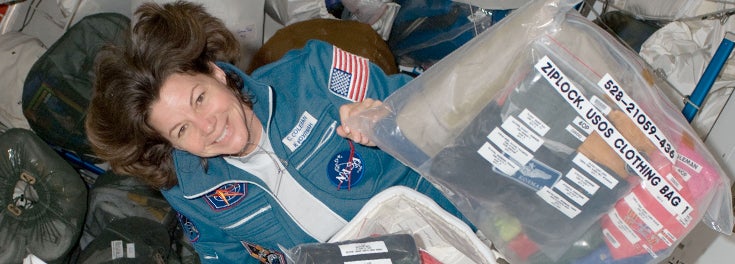
Some of us dress for comfort and others for style. But what would it be like to dress for a visit to Mars? At the University of Rhode Island, we have a professor who ponders this out-of-this world question from his office on solid ground in the Department of Textiles, Fashion Merchandising and Design.
Assistant Professor Karl Aspelund got interested in the “intravehicular apparel’’ of astronauts (clothes for on-board wear) after hearing a radio report about the 100 Year Starship, an initiative to enable travel beyond our solar system by 2112. In less time than it takes Earthlight to reach the Oort Cloud, he found himself at science conferences in Houston and Brussels, wowing engineers, astrophysicists, politicians, and space-travel enthusiasts with his ideas.
Impressed by the professor’s ingenuity, URI awarded Aspelund a research grant in 2013 to launch his project. With help from three URI graduate students and an undergraduate, he explored 3D printing, collected information about astronaut clothing, researched practices on sailing ships and submarines, examined possible fabric for radiation shielding, and investigated how to recycle space clothes. Aspelund recently sent his findings to NASA for a new grant to allow his project to continue.
We’re pretty much inventing clothing from scratch. Going to Mars and beyond is a totally different kind of existence. We can’t assume any earthly human practices are valid.
“I’m identifying what kind of clothing we need to allow humans to live and function in space, including on Mars, space stations, and starships,’’ says Aspelund. “I’m developing a few designs for short-term use. I hope to have prototypes in the next year or so. Testing these should lead us to long-term gear.’’
Typical duds worn in the International Space Station are polo shirts and cargo pants. Dirty clothes go into a supply craft that burns up on re-entry into Earth’s atmosphere. That’s fine for short trips, but not for journeys that might involve hundreds of people and last decades, maybe lifetimes.
The bottom line, says the professor, is that we need to think about ecologically friendly and sustainable ways to clean, recycle, and repair clothes in space. Traditional materials, like cotton and wool, will probably not work since fabrics need to protect against harmful radiation. “We’re pretty much inventing clothing from scratch,’’ says Aspelund. “The only thing that’s clear is that once we go for the long term, everything is open. Going to Mars and beyond is a totally different kind of existence. We can’t assume any earthly human practices are valid.’’
Professor Aspelund has clothing on the brain, but also in his blood. His grandfather was a tailor and his grandmother was a seamstress. Many of his early memories are of messing around in their shop in Iceland. But he took his passion for fabric and clothes beyond the cutting table. Now he has his sights set on infinity and beyond.
Photos courtesy of NASA.
Above: NASA astronaut Catherine (Cady) Coleman, Expedition 26 flight engineer, is pictured with a stowage container and its contents in the Harmony node of the International Space Station.
Homepage: STS-47 Mission Specialist Mae Jemison in the center aisle of the Spacelab Japan (SLJ) science module aboard the Earth-orbiting Endeavour, Orbiter Vehicle (OV) 105.
